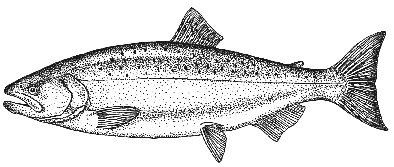
A Fisherman Looks at Chinook Salmon
-by
D.C. Reid
illustrations - Barb Krimmer
The largest of the Pacific salmon, with one 127 pound sport-caught monster having being recorded, chinook typically attain adult weights of 20 - 70 pounds. Spawning in their second to seventh year in larger river systems such as the Fraser and Yukon, longevity accounts, in part, for their size and ability to add genetic variation across brood years, a distinct advantage for preservation of the species.
An adult female lays 4,000 - 6,000 eggs. Fertilization by a single male occurs within seconds of egg deposit in autumn streambed redds. Alevins hatch within a few months and spend 6 - 14 months in freshwater, usually large rivers, before migrating to the ocean where they become resident salmon. Chinook migrate north into the Pacific Ocean for part of their life cycle but little is known about the relationship between resident and migratory phases.
In their first year, chinook weigh less than two pounds and reach lengths of 45 cm (18 inches), the size restriction for southern waters. Toward the end of their second year, chinook may reach 5 pounds or slightly less than the Georgia Strait size retention limit of 62 cm (24.5 inches). 10 to 15 pound chinook normally are two or three years old. Larger salmon represent four to seven year chinook.

Chinook salmon top the angler's desirability list for two reasons: they are the largest Pacific salmon and they are the only salmon to be found in coastal waters twelve months of the year. Annually, the summer runs of mature fish begin in May and proceed through to October when the first runs of winter, non-spawning chinook, move in to claim resident positions they occupy November through to the next May.
Handsomest of the five species, chinook may be easily distinguished from other salmon. Chinook have black gums filled with rows of pin-sharp teeth. True carnivores, these teeth make short work of their usual prey - herring, needlefish, sandlance, anchovy and squid. Well proportioned and streamlined fish, chinook are silver below and dark green dorsally. Black dots extending from behind the gill plates along the back and flowing into the tail, coupled with large scales also define this member from other osteicthyes: higher, bony fish. Flank colouring adds a purple tinge in winter and blackens in late summer. Unique in scent, chinook can be identified by their smell alone: a richly fishy armpit!
Gill rakers provide another distinguishing feature. Gill rakers are the gill bars commonly viewed when a salmon opens its gills plates to force water and thus oxygen over its gills. Chinook have 18 - 30 rough, widely-spaced gill rakers.
With respect to meat colour, chinook lay claim to being the only salmon to come in two different genetic strains: white meat and pink meat. The difference may be related to the relative preponderance of actin and myosin the two common fibres in muscle. Regardless of colour, chinook have an intermediate flavour, neither strong nor weak, and in winter their flesh stores nutrient rich oils that ensure a soft meal for the family cook.
Behaviorally, chinook habits differ from other salmon. Loosely schooling, these fish tend to inhabit particular areas for reasons other than having followed the crowd. Strongly individualistic yet structure-related, chinook, and thus fishing, concentrate on underwater land features: reefs, islands, rocks, banks, depressions in flat mud/sand bottoms. Tidal flow pushes chinook into back eddies behind structures and into calm areas where herring abound. In many areas, spawning-bound summer chinook prefer routes within a stone's through of land and have the decided habit of holing-up overnight in nooks and crannies close to shore before resuming migration.
Depth is always a consideration when fishing for chinook. Strongly light sensitive, their relative level in the water column varies greatly during the day. Summer fish move through most coastal fishing grounds within 50 feet of the surface, but in areas which do not obey this rule, Saanich Inlet for instance, chinook may be found within a few feet of the surface at the crack of dawn. By noon they have descended to 200 feet and may be as deep as 250 by two in the afternoon at which time they begin to ascend again.
Generally speaking, resident, winter chinook reside in deeper water than summer fish. While fishing depths vary, winter chinook can be located between 100 to 250 feet. Rarely do winter fish rise above these levels. For this reason, fly fishing, the most recent advent in salt water fishing, usually proves more effective in late summer months when chinook key in on surface schools of small, newly-hatched 1 ½" herring.
Interestingly enough, while summer and winter fish sometimes occupy the same fishing ground simultaneously, one "school" seldom intermingles with the other. This is because each group is found at a different level in the water, summer chinook usually residing in surface layers of water some 100 vertical feet above the in-migrating winter fish.
The key to catching chinook is to remember that they are carnivores. They hunt smaller fish particularly injured and dying members of the school. Accordingly, bait - usually anchovy or herring strip - over the long run catches more chinook in more areas. Mooching with live or just-caught herring proves deadly in slower moving water where baitfish congregate. Drift fishing lures that flutter down imitating injured baitfish do well fished to the side or just below herring balls and also just above the swarms of needlefish that sometimes carpet eelgrass-covered bottoms.
More information on Chinook Salmon & other
Game Fish
of B.C.
|




